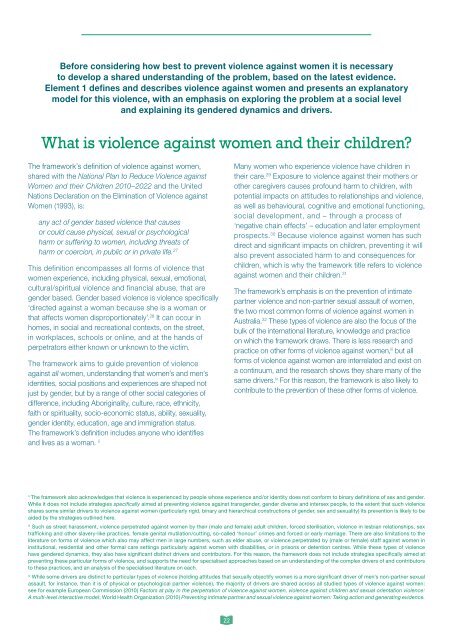Us29v
Us29v
Us29v
You also want an ePaper? Increase the reach of your titles
YUMPU automatically turns print PDFs into web optimized ePapers that Google loves.
Before considering how best to prevent violence against women it is necessary<br />
to develop a shared understanding of the problem, based on the latest evidence.<br />
Element 1 defines and describes violence against women and presents an explanatory<br />
model for this violence, with an emphasis on exploring the problem at a social level<br />
and explaining its gendered dynamics and drivers.<br />
What is violence against women and their children?<br />
The framework’s definition of violence against women,<br />
shared with the National Plan to Reduce Violence against<br />
Women and their Children 2010–2022 and the United<br />
Nations Declaration on the Elimination of Violence against<br />
Women (1993), is:<br />
any act of gender based violence that causes<br />
or could cause physical, sexual or psychological<br />
harm or suffering to women, including threats of<br />
harm or coercion, in public or in private life. 27<br />
This definition encompasses all forms of violence that<br />
women experience, including physical, sexual, emotional,<br />
cultural/spiritual violence and financial abuse, that are<br />
gender based. Gender based violence is violence specifically<br />
‘directed against a woman because she is a woman or<br />
that affects women disproportionately’. 28 It can occur in<br />
homes, in social and recreational contexts, on the street,<br />
in workplaces, schools or online, and at the hands of<br />
perpetrators either known or unknown to the victim.<br />
The framework aims to guide prevention of violence<br />
against all women, understanding that women’s and men’s<br />
identities, social positions and experiences are shaped not<br />
just by gender, but by a range of other social categories of<br />
difference, including Aboriginality, culture, race, ethnicity,<br />
faith or spirituality, socio-economic status, ability, sexuality,<br />
gender identity, education, age and immigration status.<br />
The framework’s definition includes anyone who identifies<br />
and lives as a woman. ii<br />
Many women who experience violence have children in<br />
their care. 29 Exposure to violence against their mothers or<br />
other caregivers causes profound harm to children, with<br />
potential impacts on attitudes to relationships and violence,<br />
as well as behavioural, cognitive and emotional functioning,<br />
social development, and – through a process of<br />
‘negative chain effects’ – education and later employment<br />
prospects. 30 Because violence against women has such<br />
direct and significant impacts on children, preventing it will<br />
also prevent associated harm to and consequences for<br />
children, which is why the framework title refers to violence<br />
against women and their children. 31<br />
The framework’s emphasis is on the prevention of intimate<br />
partner violence and non-partner sexual assault of women,<br />
the two most common forms of violence against women in<br />
Australia. 32 These types of violence are also the focus of the<br />
bulk of the international literature, knowledge and practice<br />
on which the framework draws. There is less research and<br />
practice on other forms of violence against women, iii but all<br />
forms of violence against women are interrelated and exist on<br />
a continuum, and the research shows they share many of the<br />
same drivers. iv For this reason, the framework is also likely to<br />
contribute to the prevention of these other forms of violence.<br />
ii<br />
The framework also acknowledges that violence is experienced by people whose experience and/or identity does not conform to binary definitions of sex and gender.<br />
While it does not include strategies specifically aimed at preventing violence against transgender, gender diverse and intersex people, to the extent that such violence<br />
shares some similar drivers to violence against women (particularly rigid, binary and hierarchical constructions of gender, sex and sexuality) its prevention is likely to be<br />
aided by the strategies outlined here.<br />
iii<br />
Such as street harassment, violence perpetrated against women by their (male and female) adult children, forced sterilisation, violence in lesbian relationships, sex<br />
trafficking and other slavery-like practices, female genital mutilation/cutting, so-called ‘honour’ crimes and forced or early marriage. There are also limitations to the<br />
literature on forms of violence which also may affect men in large numbers, such as elder abuse, or violence perpetrated by (male or female) staff against women in<br />
institutional, residential and other formal care settings particularly against women with disabilities, or in prisons or detention centres. While these types of violence<br />
have gendered dynamics, they also have significant distinct drivers and contributors. For this reason, the framework does not include strategies specifically aimed at<br />
preventing these particular forms of violence, and supports the need for specialised approaches based on an understanding of the complex drivers of and contributors<br />
to these practices, and an analysis of the specialised literature on each.<br />
iv<br />
While some drivers are distinct to particular types of violence (holding attitudes that sexually objectify women is a more significant driver of men’s non-partner sexual<br />
assault, for instance, than it is of physical or psychological partner violence), the majority of drivers are shared across all studied types of violence against women:<br />
see for example European Commission (2010) Factors at play in the perpetration of violence against women, violence against children and sexual orientation violence:<br />
A multi-level interactive model; World Health Organization (2010) Preventing intimate partner and sexual violence against women: Taking action and generating evidence.<br />
22


